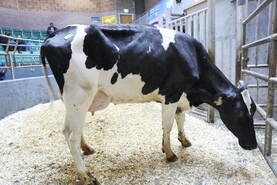As the weather picks up and cattle are now been left out its time to consider dosing plans. With most lambing now done it is also advisable to consider a dosing strategy for sheep.
As the weather picks up the main risk for lambs in the short-term would be nemadtodirus battus.
These eggs usually will be on pasture from the previous year and with temperatures above 10 degrees for seven days or more you can potentially see mass hatching if weather conditions are favourable. FECs can often be negative in acute cases so it is worth assessing risk and potentially giving a white dose before or around risk period.
Coccidiosis
Also coccidiosis in lambs at this stage continues to be a problem. Again know your risk and avoid lambs congregating in areas of heavy faecal contamination. I often find moving creep feeders or not allowing dirt to build up around drinkers can help. If you know your flock is at risk of coccidiosis then a preventative dose now can be very useful before issues arise.
Grazing plans and worm exposure
Going forward into the summer it is very useful to look at grazing plans. Minimising worm exposure through pasture rotation can help sometimes, but this can be very much farm dependent.
Preventing young lambs from consistently grazing the same pastures each spring reduces worm exposure. Now due to the fact resistance is a huge issue in sheep I strongly recommend faecal egg counts throughout the summer.
I usually recommend that five lambs and five thin ewes are checked at intervals of four to six weeks during the summer. Checking can often lead to better timing of dosing and may give an early indication of any worm resistance issues within the flock.
Worm resistance
If farmers have any concerns about worm resistance then drenching tests should be done.
This involves taking some faecal samples predosing and again repeating in seven or 14 days depending on what dose is used. This is called faecal egg reduction test and we are looking to see a reduction of greater than 95% after dosing.
Of course variables can change but being proactive about worming can be hugely beneficial.
By following FECs results you can time dosing better but also it will give a good indication of the effectiveness of the current dosing strategy. It is worth noting that before using any dose you should talk to your vet about which one is best suited to your flock. Also make sure all dosing guns are calibrated and always dose to the heaviest weight in the batch.
Proactivity
While cattle worm resistance is not yet a concern we should be wary of what is happening in the sheep industry as a warning to be more proactive about worm dosing. The main risks for cattle are first and second grazers. Although adult cows build a natural immunity to most gut parasites, they are of course at risk from fluke and mange. I have also seen adult dairy cows being exposed to lungworm from June on. So with beef cattle I like to regularly check worm eggs counts and then decide what products and when they should be used.
Young beef calves are low risk due to suckling for the first month on grass. Dosing or FECs should be considered after four to six weeks out on pasture. Again be aware of coccidiosis risks where it has been an issue previously. What we often see is that calves start the infection ingesting oocysts inside but often only show symptoms later when at grass. Any scouring batches of calves should definitely have dung samples taken to rule out potential parasites. I have seen cases of giardia and rumen fluke occasionally between May and July, that we only diagnosed by checking faecal samples from scouring cases.
Informed dosing decisions
I feel we must move away from set dosing schedules and make more informed dosing decisions in conjunction with faecal egg counts. We also use adult flukicides for adult cows in herds that are high risk of fluke at turnout or before to reduce the shedding of eggs on pasture. For the most part however liver fluke is primary risk late summer early autumn. All farmers should be aware of lungworm from June on. Again dependent on weather conditions and stocking and grazing patterns. This primarily effects first and second grazers.
For dairy calves it is again useful to try strategic dosing when needed. Lungworm continues to be a concern in certain dairy farms in adult cows. Where suspected it is best practice to sit down and draw up a control plan. I find bulk milk samples useful as a guide also to parasites levels in adult dairy cows especially later on in the year.
So sit down and draw up a plan, when to test, when to dose and what to dose with. Of course variables can change but being proactive about worming can be hugely beneficial.






 This is a subscriber-only article
This is a subscriber-only article









SHARING OPTIONS: